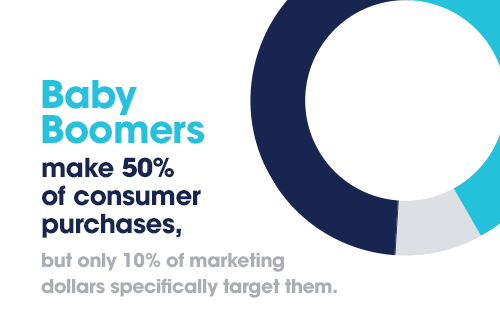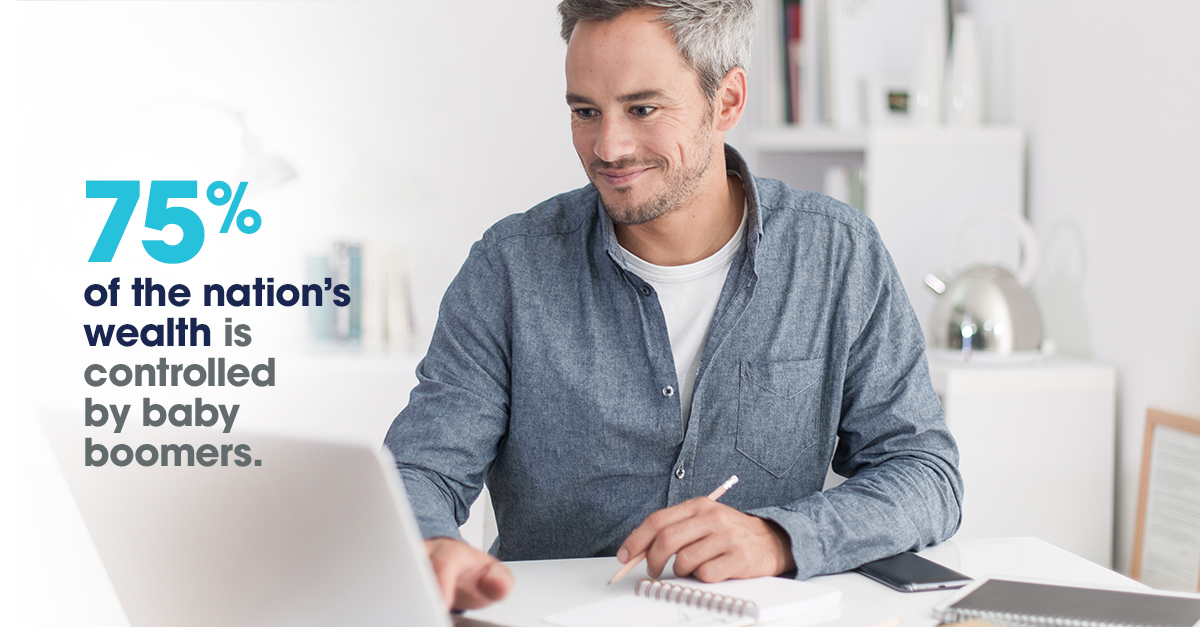What do Amazon, Nike, and Finis have in common?
They all understand the value in marketing to seniors – a powerful demographic that’s overlooked by most brands.
While it’s common to see in-store promotions and “senior day” discounts at brick-and-mortar stores, online marketing to seniors still lags behind marketing spend on other age groups. That’s because many brands think seniors:
- Have little wealth and are afraid to spend it.
- Are a smaller and less digitally active group than younger adults.
- Are sitting in rocking chairs watching life go by.
Well, they’re not.
According to AARP, Baby boomers account for 50% of all consumer purchases, but only 10% of marketing dollars are specifically targeting them.
The truth is, seniors today are a large and vital group with considerable spending power. And if your marketing programs are mainly focused on younger segments, you’re missing out on a huge and lucrative opportunity.


Seniors Are Everywhere
The demographic referred to as “seniors” makes up a very large and diverse swath of our population. AARP defines seniors as anyone age 50 and over, and their numbers alone make them force to be reckoned with. In the US, they represent:
- 109 million strong.
- 33% of the population.
- 43% of the adult population.
Even if you go with the more restrictive parameters of the baby boomer generation (which AARP defines as ages 54 – 72), you’re looking at 81.5 million people – that’s more than 32% of the US adult population!
The number of millennials in the US is roughly the same, at 82 million, but AdWeek reported that marketers are spending 500% more on them than all other age groups combined.
If your customer acquisition strategy doesn’t include marketing to seniors, you’re missing out on a huge source of potential revenue. It’s time to rethink your assumptions about seniors and their buying habits.
Seniors Have Economic Clout
It may surprise you to know that baby boomers are the richest generation in history. With $3.2 trillion in spending power, they control 75% of the nation’s wealth. And 50+ households:
- Own 61% of all investments.
- Are 41% more likely to own investments than 18-49 year-olds.
- Have a median household net worth of $293,000 (compared to $175,000 for people 18-49).


Seniors Aren’t Receding Into the Background
People over 55 are a very significant and vital part of the workforce. They’re working longer – average retirement age today is 68 (up from 64 in 1998). And they often have seniority, which means they’re likely earning higher pay as well.
They’re also living longer and spending their time being more active. At 78.6 years, today’s life expectancy is nearly ten years higher than it was half a century ago.
And seniors are putting that time to good use.
The Bureau of Labor Statistics reported that Americans 75 and over spend nearly 8 hours a day in leisure and sports activities. And if that amount of time isn’t striking enough, consider that it’s 30% more than 15- to 19-year olds (5.6 hours), and more than twice as much as 25- to 44-year olds (3.95 hours).
Seniors Are Digitally Engaged
You may think seniors fear technology, but they don’t. Fifty-seven percent of baby boomers use social media, and seniors comprise one-third of all online and social media users.
And seniors aren’t just checking Facebook, they’re engaging in the digital economy. Forty-four percent of boomers make online purchases every month, and online shopping is the second highest online activity they engage in.


Are You Marketing to the Senior Segment?
As the director of AARP’s thought leadership division once said, “You’d have to be an idiot to turn your back on this humongous growth market.”
If you’re like most marketers, you probably didn’t realize the senior segment was so lucrative, but it’s not too late to act. If you let go of our culture’s outdated assumptions and make them a bigger part of your strategy, you can seize an opportunity that’s ripe and available.
The only question that remains is how to effectively reach this group and make your senior marketing program a competitive advantage.
Marketing to Seniors with Gated Offers is a Terrific Strategy
Exclusive gated offers are targeted discounts or offers that recognize and honor specific groups, such as students, teachers, or the military, and people find them highly appealing. In our consumer survey, 94% of Americans said they would take advantage of one, and 68% said they carry more weight than traditional coupons.
People in the 55+ age group are particularly motivated by them:
- 61% say they would feel rewarded by one.
- Nearly 1 in 2 (48%) would make a purchase sooner.
- More than half (54%) said it increases their likelihood to purchase.
- 95% said they would share it with their family or friends.
Create a Gated Offer and Use SheerID to Secure It
SheerID’s Digital Verification Platform makes it easy to ensure that only eligible shoppers receive your senior discount. Our platform’s age verification covers the entire US population over 50 – that’s 109 million people – and the age range is adjustable, allowing you to target any age group as precisely as you want. In addition, our exclusive relationship with AARP provides an easy way to identify all 38 million members without requiring a physical card to be presented.
The process is quick: buyers enter minimal data and are verified instantly. This creates a frictionless, in-brand experience that occurs seamlessly within the purchase process.
It also keeps your offer secure. Our customer audit revealed that discount abuse can be as high as 35%. SheerID’s age verification prevents ineligible shoppers from redeeming your offer and ensures that only your intended audience receives it.


For more information on how to leverage the power of gated offers to tap into the senior market, read the following blog posts:








